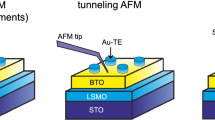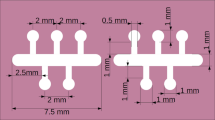Abstract
ESTIMATES of the thickness of oxide films on metals have long been made by immersion in an electrolyte and measurement of the capacity of the condenser formed by the film as dielectric1. It has, however, been pointed out by R. Huddle (private communication) that such measurements are liable to error if the film contains cracks, for these permit the electrolyte to approach closer to the metal/oxide interface. This should cause the ‘capacity’ thickness to be less than that derived from measurements of gain of weight, for example. A rise in the capacity of anodized films under condition of breakdown has been reported by Young1.
This is a preview of subscription content, access via your institution
Access options
Subscribe to this journal
Receive 51 print issues and online access
$199.00 per year
only $3.90 per issue
Buy this article
- Purchase on Springer Link
- Instant access to full article PDF
Prices may be subject to local taxes which are calculated during checkout
Similar content being viewed by others
References
Young, L., Trans. Farad. Soc., 51, 1250 (1955).
Thomas, D. E., “The Metallurgy of Zirconium”, 608, edit. Lustman and Kerze (McGraw-Hill, 1955).
Charlesby, A., A.E.R.E., M/R 1176 (1953).
Adams, G. B., Maraghini, M., and Van Rysselberghe, P., AECU.2918 (1954).
Author information
Authors and Affiliations
Rights and permissions
About this article
Cite this article
WANKLYN, J. Use of Capacity Measurements for the Study of Oxide Films on Metals. Nature 177, 849–850 (1956). https://doi.org/10.1038/177849b0
Issue Date:
DOI: https://doi.org/10.1038/177849b0
This article is cited by
Comments
By submitting a comment you agree to abide by our Terms and Community Guidelines. If you find something abusive or that does not comply with our terms or guidelines please flag it as inappropriate.



